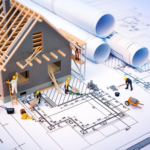We offer a wide range of loan options to meet every borrower’s needs. With different document requirements, loan amounts, and loan types to choose from, you’ll be amazed at how many possibilities there are. Let us help you find the perfect loan to get you into your dream home!
 Home loan where the interest rate stays the same throughout the life of the loan. The monthly payments will remain consistent, making it easier to budget over time. Typically, these loans require a down payment of at least 3-20%. They are a great option for buyers who plan to stay in the home long-term and prefer the stability of predictable payments.
Home loan where the interest rate stays the same throughout the life of the loan. The monthly payments will remain consistent, making it easier to budget over time. Typically, these loans require a down payment of at least 3-20%. They are a great option for buyers who plan to stay in the home long-term and prefer the stability of predictable payments.
 A loan with an interest rate that starts off low, but can change periodically after an initial fixed period (usually 3, 5, 7, or 10 years). After the initial period, the rate adjusts based on market conditions, which means the monthly payments could go up. ARMs can be a good option for buyers who plan to sell or refinance before the rate adjusts, but they come with more risk due to potential rate increases over time.
A loan with an interest rate that starts off low, but can change periodically after an initial fixed period (usually 3, 5, 7, or 10 years). After the initial period, the rate adjusts based on market conditions, which means the monthly payments could go up. ARMs can be a good option for buyers who plan to sell or refinance before the rate adjusts, but they come with more risk due to potential rate increases over time.
 A type of loan that exceeds the conforming loan limits set by the Federal Housing Finance Agency (FHFA), typically for high-value homes. They often come with stricter requirements, such as a higher credit score, larger down payment, and a more thorough approval process. Jumbo mortgages are ideal for buyers looking to finance luxury homes or properties in high-cost areas.
A type of loan that exceeds the conforming loan limits set by the Federal Housing Finance Agency (FHFA), typically for high-value homes. They often come with stricter requirements, such as a higher credit score, larger down payment, and a more thorough approval process. Jumbo mortgages are ideal for buyers looking to finance luxury homes or properties in high-cost areas.
D esigned to help first-time homebuyers or those with less-than-perfect credit qualify for a mortgage. FHA loans typically require a lower down payment (as low as 3.5%) and have more flexible credit requirements compared to conventional loans. However, borrowers must pay mortgage insurance premiums (MIP) as part of the loan, which helps protect the lender in case of default.
esigned to help first-time homebuyers or those with less-than-perfect credit qualify for a mortgage. FHA loans typically require a lower down payment (as low as 3.5%) and have more flexible credit requirements compared to conventional loans. However, borrowers must pay mortgage insurance premiums (MIP) as part of the loan, which helps protect the lender in case of default.
B acked by the U.S. Department of Veterans Affairs (VA) and is available to eligible veterans, active-duty service members, and sometimes their families. VA loans typically offer several benefits, including no down payment, no private mortgage insurance (PMI) requirement, and competitive interest rates. These loans are designed to make homeownership more accessible for those who have served in the military.
acked by the U.S. Department of Veterans Affairs (VA) and is available to eligible veterans, active-duty service members, and sometimes their families. VA loans typically offer several benefits, including no down payment, no private mortgage insurance (PMI) requirement, and competitive interest rates. These loans are designed to make homeownership more accessible for those who have served in the military.
A USDA Mortgage is a government-backed loan offered by the U.S. Department of Agriculture (USDA) to help low- and moderate-income buyers purchase homes in rural or suburban areas. USDA loans often require no down payment and have lower interest rates, making them an attractive option for eligible buyers. These loans are designed to encourage homeownership in less densely populated areas, with specific income and location requirements to qualify.
USDA Mortgage is a government-backed loan offered by the U.S. Department of Agriculture (USDA) to help low- and moderate-income buyers purchase homes in rural or suburban areas. USDA loans often require no down payment and have lower interest rates, making them an attractive option for eligible buyers. These loans are designed to encourage homeownership in less densely populated areas, with specific income and location requirements to qualify.
 A Construction Loan is a short-term loan used to finance the building of a new home or major renovations. These loans typically cover the cost of construction materials, labor, and other associated expenses. During the construction phase, the borrower typically makes interest-only payments, and the loan is paid off or converted into a permanent mortgage once the home is completed. Construction loans can be a great option for buyers looking to custom-build their dream home.
A Construction Loan is a short-term loan used to finance the building of a new home or major renovations. These loans typically cover the cost of construction materials, labor, and other associated expenses. During the construction phase, the borrower typically makes interest-only payments, and the loan is paid off or converted into a permanent mortgage once the home is completed. Construction loans can be a great option for buyers looking to custom-build their dream home.
 A Renovation Loan is a type of loan that allows homebuyers or homeowners to finance both the purchase or refinancing of a home and the cost of necessary renovations or improvements. Common examples include the FHA 203(k) loan or Fannie Mae’s HomeStyle Renovation loan. These loans are ideal for buyers or homeowners who want to buy a fixer-upper or fund home improvements, with the renovation costs built into the mortgage.
A Renovation Loan is a type of loan that allows homebuyers or homeowners to finance both the purchase or refinancing of a home and the cost of necessary renovations or improvements. Common examples include the FHA 203(k) loan or Fannie Mae’s HomeStyle Renovation loan. These loans are ideal for buyers or homeowners who want to buy a fixer-upper or fund home improvements, with the renovation costs built into the mortgage.
A Non-QM Bank Statement Loan is a type of mortgage that doesn't require traditional documentation like W-2s or tax returns. Instead, it uses bank statements—typically the last 12 to 24 months—to verify income. This makes it an appealing option for self-employed individuals or business owners who may have irregular income or tax filings. Non-QM Bank Statement loans offer more flexibility in qualifying but may come with higher interest rates and stricter requirements compared to conventional loans.
that doesn't require traditional documentation like W-2s or tax returns. Instead, it uses bank statements—typically the last 12 to 24 months—to verify income. This makes it an appealing option for self-employed individuals or business owners who may have irregular income or tax filings. Non-QM Bank Statement loans offer more flexibility in qualifying but may come with higher interest rates and stricter requirements compared to conventional loans.
 A Non-QM DSCR Loan (Debt Service Coverage Ratio Loan) is a type of mortgage primarily used for investment properties. It focuses on the property's ability to generate rental income rather than the borrower’s personal income. The loan is typically approved based on the property’s DSCR, which is the ratio of its rental income to its debt payments. This makes it an attractive option for real estate investors who may not have traditional income documentation but want to leverage their property’s cash flow to qualify for financing.
A Non-QM DSCR Loan (Debt Service Coverage Ratio Loan) is a type of mortgage primarily used for investment properties. It focuses on the property's ability to generate rental income rather than the borrower’s personal income. The loan is typically approved based on the property’s DSCR, which is the ratio of its rental income to its debt payments. This makes it an attractive option for real estate investors who may not have traditional income documentation but want to leverage their property’s cash flow to qualify for financing.
 A Non-QM ITIN Loan is a type of mortgage designed for individuals who have an Individual Taxpayer Identification Number (ITIN) instead of a Social Security number. These loans are available to borrowers who may not have a traditional credit history or legal residency status in the U.S., but who are still able to demonstrate financial stability through alternative documentation, such as bank statements or rent history. Non-QM ITIN loans offer a path to homeownership for immigrants or non-citizens who meet the lender’s requirements, though they may come with higher interest rates and more flexible terms than traditional loans.
A Non-QM ITIN Loan is a type of mortgage designed for individuals who have an Individual Taxpayer Identification Number (ITIN) instead of a Social Security number. These loans are available to borrowers who may not have a traditional credit history or legal residency status in the U.S., but who are still able to demonstrate financial stability through alternative documentation, such as bank statements or rent history. Non-QM ITIN loans offer a path to homeownership for immigrants or non-citizens who meet the lender’s requirements, though they may come with higher interest rates and more flexible terms than traditional loans.
1099 Loans and P&L Only Loans are types of Non-QM (Non-Qualified Mortgage) options designed for self-employed borrowers or those with non-traditional income documentation.
1099 Loans: These loans are specifically for self-employed individuals or independent contractors who receive a 1099 form rather than a W-2. Instead of relying on tax returns, lenders use the borrower’s 1099 forms to assess income, making this a great option for those with fluctuating earnings or non-traditional income sources.
P&L Only Loans (Profit and Loss Statement Loans): These loans allow self-employed borrowers to qualify based on their Profit and Loss (P&L) statements instead of tax returns. Lenders typically require the P&L statement to be prepared by a certified accountant to verify income. This option is ideal for business owners who may not show consistent income on tax returns but can demonstrate their profitability through their P&L statements.
Both of these Non-QM loans provide more flexibility than traditional mortgage options and cater to individuals with unique income situations, though they may have higher interest rates or more stringent requirements.
 A Non-Warrantable Condo Loan is a type of mortgage for condos that do not meet the standard requirements set by government-backed agencies like Fannie Mae or Freddie Mac. These properties may have issues such as a high percentage of units rented out, low owner occupancy, pending litigation, or other factors that make them ineligible for traditional financing. Non-warrantable condo loans are offered by private lenders or banks and may come with higher interest rates or stricter requirements, but they provide an option for buyers interested in purchasing a condo that doesn’t meet typical loan guidelines.
A Non-Warrantable Condo Loan is a type of mortgage for condos that do not meet the standard requirements set by government-backed agencies like Fannie Mae or Freddie Mac. These properties may have issues such as a high percentage of units rented out, low owner occupancy, pending litigation, or other factors that make them ineligible for traditional financing. Non-warrantable condo loans are offered by private lenders or banks and may come with higher interest rates or stricter requirements, but they provide an option for buyers interested in purchasing a condo that doesn’t meet typical loan guidelines.
 A Foreign National Loan is a type of mortgage designed for non-U.S. citizens or residents who wish to purchase property in the United States. These loans are available to individuals who may not have a U.S. credit history or a Social Security number, but still meet other financial qualifications. Foreign national loans typically require a larger down payment, often around 30% or more, and may have higher interest rates compared to traditional loans. They are ideal for international buyers looking to invest in U.S. real estate.
A Foreign National Loan is a type of mortgage designed for non-U.S. citizens or residents who wish to purchase property in the United States. These loans are available to individuals who may not have a U.S. credit history or a Social Security number, but still meet other financial qualifications. Foreign national loans typically require a larger down payment, often around 30% or more, and may have higher interest rates compared to traditional loans. They are ideal for international buyers looking to invest in U.S. real estate.
 A Reverse Mortgage is a type of loan available to homeowners age 62 or older, allowing them to convert a portion of their home’s equity into cash. Unlike traditional mortgages, there are no monthly payments; instead, the loan is repaid when the homeowner sells the home, moves out, or passes away. Reverse mortgages can provide financial relief for retirees, offering a steady stream of income while allowing them to remain in their home. However, the loan balance increases over time, and the home’s equity decreases as funds are drawn.
A Reverse Mortgage is a type of loan available to homeowners age 62 or older, allowing them to convert a portion of their home’s equity into cash. Unlike traditional mortgages, there are no monthly payments; instead, the loan is repaid when the homeowner sells the home, moves out, or passes away. Reverse mortgages can provide financial relief for retirees, offering a steady stream of income while allowing them to remain in their home. However, the loan balance increases over time, and the home’s equity decreases as funds are drawn.
A HELOC (Home Equity Line of Credit) is a revolving credit line that allows homeowners to borrow against the equity in their home . It works like a credit card, where you can borrow, repay, and borrow again, typically with a variable interest rate.
. It works like a credit card, where you can borrow, repay, and borrow again, typically with a variable interest rate.
A Home Equity Loan (HELOAN), on the other hand, is a lump-sum loan with a fixed interest rate, where you borrow a set amount based on your home’s equity and repay it in fixed monthly installments.
Both options allow homeowners to tap into their home equity for things like home improvements, debt consolidation, or major expenses, but they differ in terms of repayment structure and flexibility.
 A Hard Equity Loan (often referred to as a Hard Money Loan) is a type of short-term loan secured by the value of a property, rather than the borrower’s creditworthiness. These loans are typically provided by private lenders or investors and are used for real estate transactions, such as property flips or urgent financing needs. Hard equity loans have higher interest rates and shorter repayment terms compared to traditional loans, but they offer quicker approval processes and are often used by borrowers who may not qualify for conventional financing due to credit issues or unique property situations.
A Hard Equity Loan (often referred to as a Hard Money Loan) is a type of short-term loan secured by the value of a property, rather than the borrower’s creditworthiness. These loans are typically provided by private lenders or investors and are used for real estate transactions, such as property flips or urgent financing needs. Hard equity loans have higher interest rates and shorter repayment terms compared to traditional loans, but they offer quicker approval processes and are often used by borrowers who may not qualify for conventional financing due to credit issues or unique property situations.
Helping our customers offord the home of their dreams is what we do!
Many years of experience and happy customers speak volumes about what we love.
Company NMLS: 1659700